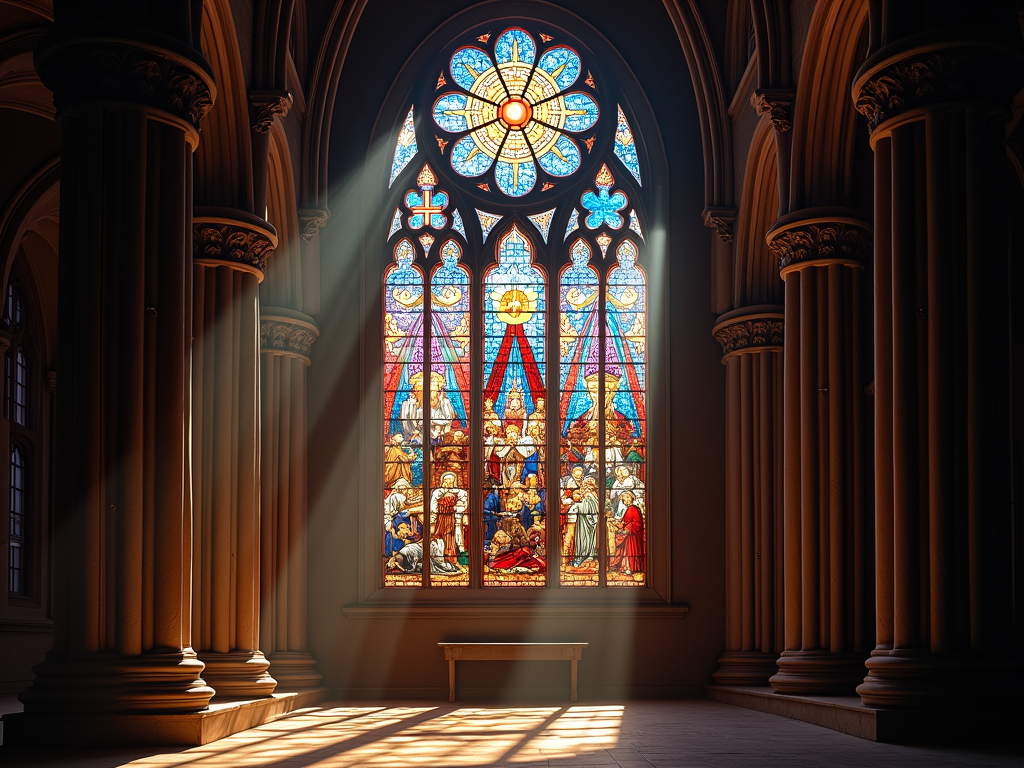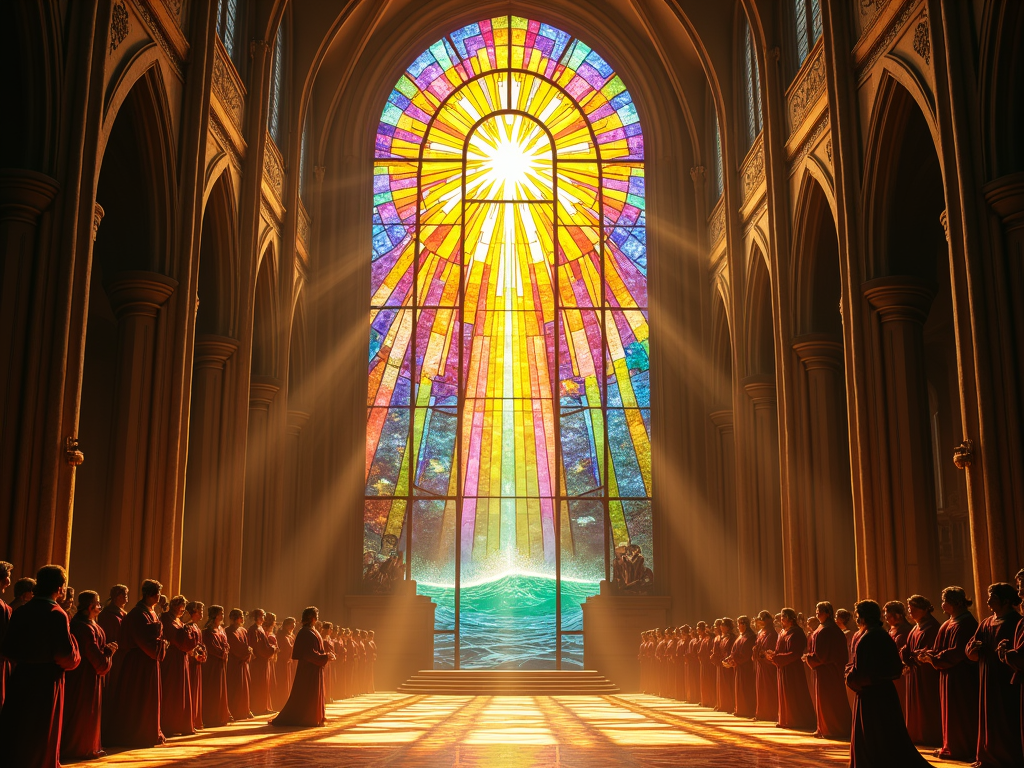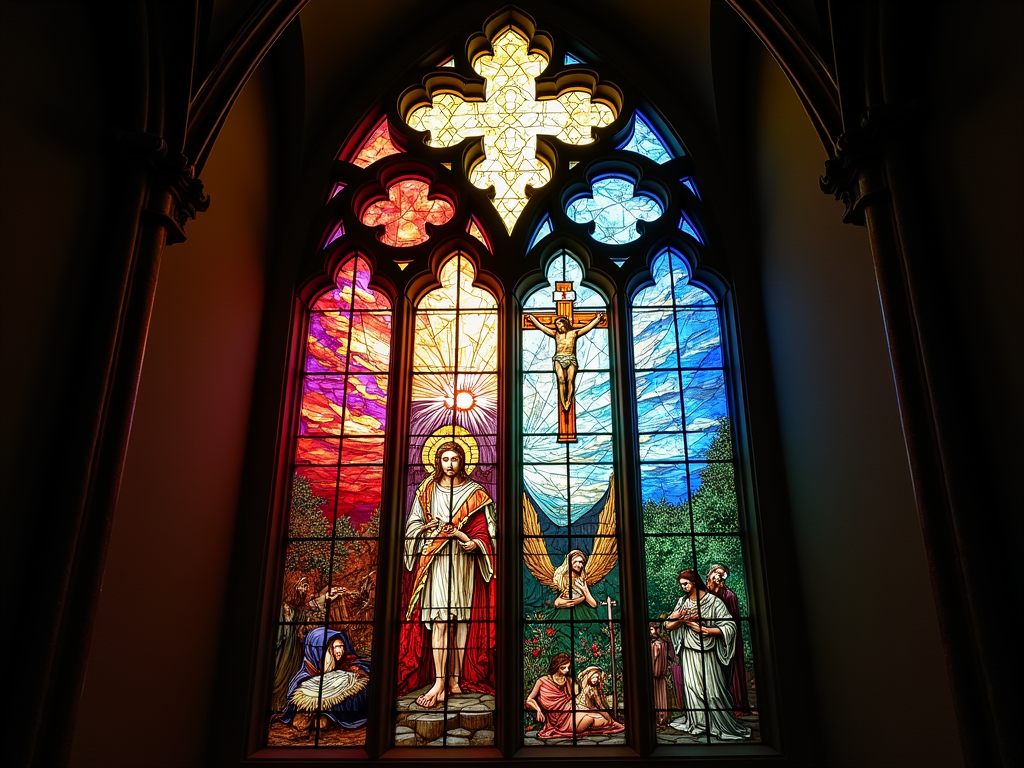
Key Takeaways
- Biblical imagery of light and precious stones provided the foundation for stained glass symbolism in churches.
- Each color in stained glass windows carries specific spiritual meanings, with blue representing heaven, red symbolizing Christ’s sacrifice, and gold depicting divine presence.
- The windows served as a “poor man’s Bible,” making biblical stories accessible to illiterate congregations through visual narratives.
- While not directly commanded in Scripture, stained glass windows align with biblical traditions of beautifying worship spaces.
- The combination of colored light and religious imagery creates an atmosphere of sacred space that enhances worship experiences.
Stained Glass and Biblical Beauty in Worship
The artistry of stained glass connects deeply to Scripture’s emphasis on beauty in worship. Though the Bible doesn’t directly mention these windows, their development fits naturally with the biblical focus on using visual elements to teach faith. Medieval craftsmen transformed basic materials into stunning displays that captured light and story in ways that still move people today. These windows continue to serve their original purpose – they teach, inspire, and create sacred spaces that point to God’s glory.
The Lasting Impact of Stained Glass
Stained glass has endured as a meaningful part of church architecture because it speaks to both mind and heart. The windows blend artistic excellence with spiritual purpose, making them more than just decorative features. Their lasting impact stems from their ability to communicate truth through beauty, a principle found throughout Scripture.
The Sacred Symbolism Behind Stained Glass Materials in Scripture
Biblical References to Glass and Precious Stones
Stained glass has deep roots in biblical symbolism, drawing inspiration from sacred texts that detail precious materials and divine light. The Book of Revelation paints a vivid picture of the New Jerusalem adorned with twelve foundation stones, each carrying profound spiritual meaning. These stones – jasper, sapphire, agate, emerald, onyx, carnelian, chrysolite, beryl, topaz, chrysoprase, jacinth, and amethyst – laid the groundwork for medieval stained glass symbolism.
I’ve found that glass itself appears in striking biblical imagery. In Revelation, a “sea of glass” stretches before God’s throne, creating an image of crystal-clear purity. This reference is particularly interesting since ancient glass was typically more opaque than our modern versions.
Light plays a central role in biblical teachings, with Jesus declaring “I am the light of the world” in John 8:12. This divine illumination concept influenced how early churches used stained glass. Here are key elements of biblical light symbolism that shaped stained glass use:
- Genesis describes light as God’s first creation, setting its spiritual significance
- Psalm 27:1 refers to the Lord as “my light and my salvation”
- Colored light through stained glass represented divine presence
- The twelve stone colors matched the tribes of Israel and the apostles
- Each color carried specific spiritual meanings in church teachings
The creation of stained glass windows became a way to translate these biblical references into visual teachings. The materials used weren’t just decorative – they carried deep spiritual significance that connected worshippers to sacred texts.

The Rainbow of Religious Meaning: Color Symbolism in Church Windows
Colors in stained glass tell a rich spiritual story that deepens our understanding of biblical messages. Each hue carries powerful symbolic meanings that have shaped religious stained glass symbolism through centuries of church architecture.
Primary Colors and Their Sacred Significance
Blue stands as one of the most prevalent colors in church windows, representing the vastness of Heaven and divine truth. Looking at a deep blue panel can remind us of God’s infinite wisdom and the hope He provides. Red holds special significance as it symbolizes Christ’s ultimate sacrifice and the depth of His love for humanity. I’ve noticed these powerful reds often appear in scenes depicting the crucifixion or in panels representing divine love.
Green brings life to biblical narratives through its connection to growth and renewal. You’ll spot this color in scenes of creation or resurrection, highlighting themes of rebirth. Yellow and gold panels catch sunlight brilliantly, creating an otherworldly glow that represents God’s divine presence and glory in the church space.
Secondary Colors and Their Biblical Meaning
The rich tones of purple appear frequently in historical church windows, symbolizing both royal majesty and spiritual reflection. This dual meaning makes purple particularly powerful during periods of penitence like Lent. White glass radiates purity and holiness, often featured in scenes of the resurrection or heavenly realms.
Dark colors also play their part in telling biblical stories. Black appears sparingly but purposefully, representing death or evil in narrative scenes. Brown grounds many compositions with its earthly associations, reminding us of humility and our connection to God’s creation.
Common Color Combinations in Biblical Scenes
- Nativity scenes often combine pure white for Christ’s innocence with royal purple for His kingship.
- Crucifixion windows feature deep reds symbolizing sacrifice alongside hopeful blues.
- Paradise scenes blend vibrant greens with heavenly golds.
- Resurrection stories pair triumphant whites with life-affirming greens.
- Scenes of judgment might contrast stark blacks with divine yellows.
This thoughtful use of color in crafting stained glass windows creates a visual language that helps tell biblical stories and enhance worship experiences. The interplay of these meaningful hues transforms ordinary light into powerful messages of faith, turning each window into a sermon in glass.

Biblical Stories Told Through Glass
Stained glass windows serve as stunning visual narratives of Biblical teachings. My experience studying these magnificent artworks has shown how they bring scripture to life through vibrant colors and intricate designs.
Sacred Stories in Colored Light
The Old Testament comes alive through beautifully crafted stained glass scenes that capture pivotal moments. These windows tell the story of Creation, with light streaming through colored panes to show God separating darkness from light. The great Flood appears frequently, depicting Noah’s ark surrounded by rising waters and the promise of the rainbow. The dramatic giving of the Ten Commandments to Moses on Mount Sinai stands as another powerful scene.
The life of Christ takes center stage in many historical church windows, telling His story from birth to resurrection. I’ve noticed these scenes typically include:
- The Nativity, showing Jesus in the manger with Mary, Joseph, and the visiting shepherds
- Key miracles performed during His ministry, like turning water into wine
- The Last Supper with His disciples
- The Crucifixion and subsequent Resurrection
Beyond these major narratives, the windows incorporate important Christian symbols that carry deep spiritual meaning:
- The dove representing the Holy Spirit
- The lamb symbolizing Christ as the Lamb of God
- The fish, an early secret symbol of Christian faith
- The Alpha and Omega letters signifying God as the beginning and end
- The cross as the central symbol of Christian faith
The artisans who create these stained glass masterpieces also include scenes from the Acts of the Apostles, showing the early church’s growth and the spread of Christianity. Saints and martyrs feature prominently, their stories preserved in glass to inspire future generations. These windows don’t just decorate – they teach, inspire, and connect viewers to their faith through visual storytelling.

From Roman Times to Gothic Cathedrals
The stunning craft of stained glass first appeared during the Roman Empire, with artisans mastering colored glass techniques in their secular buildings and early places of worship. I’ve traced this beautiful art form’s path from these humble beginnings to its spectacular peak in medieval Gothic cathedrals, where stained glass history transformed religious architecture forever.
Biblical Context and Religious Use
The Bible doesn’t directly mention stained glass windows or provide specific instructions about their use in worship spaces. Yet, this decorative art form became one of Christianity’s most powerful teaching tools. I find it fascinating how stained glass symbolism developed to tell biblical stories through vibrant colors and intricate designs. These windows served as visual sermons for congregations who couldn’t read – a “poor man’s Bible” that brought Scripture to life through radiant light and color.
Beyond Christian Worship
While Gothic cathedrals showcase the most famous examples of religious stained glass, this art form wasn’t limited to Christian worship. The technique spread across different faiths, finding its way into Islamic mosques and Jewish synagogues. Each religious tradition adapted stained glass crafting techniques to fit their own artistic and spiritual expressions.
The practical purpose of these windows extended beyond mere decoration. They created an atmosphere of sacred space through filtered, colored light that seemed to dance across stone walls and floors. This effect helped worshippers feel closer to the divine, even though no biblical text specifically endorsed such architectural features.
Here’s how stained glass windows enhanced religious worship:
- They depicted biblical narratives in sequential panels, making complex stories accessible to all
- The changing light throughout the day created different moods for prayer and contemplation
- Colored light symbolized divine presence, reminiscent of descriptions of God’s glory in religious texts
- The windows served as permanent visual reminders of faith’s central teachings
- They united communities through shared visual experiences of sacred stories
Just as medieval craftsmen created stained glass masterpieces to honor their faith, modern religious buildings continue this tradition. While Scripture doesn’t command or forbid stained glass, its use aligns with accepted practices of beautifying worship spaces – much like the artistic details that adorned the biblical Temple of Solomon.
The enduring legacy of these windows proves their value beyond mere decoration. They’ve shaped religious architecture for centuries, creating spaces where fascinating aspects of stained glass continue to inspire and educate believers today, regardless of their literacy level or religious background.

Sources:
The Holy Bible (Various Translations: NIV, KJV, ESV, etc.)
The Bible Knowledge Commentary, Walvoord and Zuck
Rose Windows, Painton Cowen
Stained Glass: History, Technology and Preservation, Susan Brown
The History and Technique of Stained Glass, Le Couteur
The History of Stained Glass: The Art of Light Medieval to Contemporary, Virginia Chieffo Raguin
